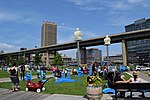Buffalo Niagara Medical Campus
2001 establishments in New York (state)Education in Buffalo, New YorkHealthcare in Buffalo, New YorkMedical and health organizations based in New York (state)University at Buffalo

The Buffalo Niagara Medical Campus (BNMC) is a medical center of health care, life sciences research and medical education institutions, co-located on 120 acres (49 ha) in Buffalo, New York. The BNMC was founded in 2001 by a consortium (including the University at Buffalo School of Medicine and Roswell Park Comprehensive Cancer Center). This project comprises one of the five "Strategic Investment Areas" that make up Buffalo, NY's Queen City Hub Plan, the city's strategic plan for urban redevelopment.
Excerpt from the Wikipedia article Buffalo Niagara Medical Campus (License: CC BY-SA 3.0, Authors, Images).Buffalo Niagara Medical Campus
Washington Street, Buffalo
Geographical coordinates (GPS) Address Nearby Places Show on map
Geographical coordinates (GPS)
| Latitude | Longitude |
|---|---|
| N 42.895747541719 ° | E -78.869364502578 ° |
Address
Trico Plant #1
Washington Street 817
14203 Buffalo
New York, United States
Open on Google Maps











